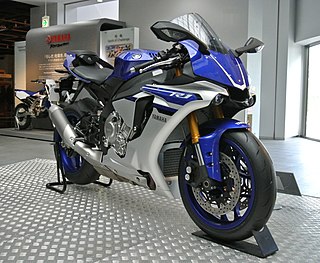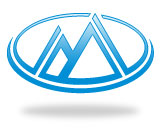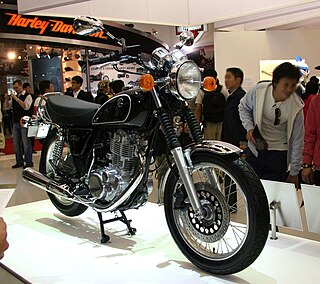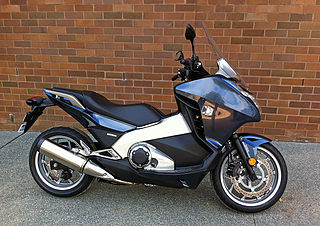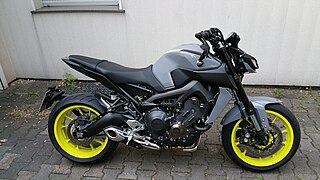 1st Generation Yamaha XP500 TMAX | |
| Manufacturer | Yamaha Motor Company |
|---|---|
| Also called | XP500 |
| Production | 2001–Present |
| Class | Maxi-scooter |
| Engine | 499 cm3 (30.5 cu in) Liquid-cooled 4-stroke DOHC parallel-twin |
| Bore / stroke | 66 mm × 73 mm (2.6 in × 2.9 in) |
| Compression ratio | 10.0:1 for model years 2001-2003, 11.0:1 for model years 2004-2011 |
| Top speed | 100 mph (160 km/h) [1] |
| Power | 29.4 kW (39.4 hp) at 7,000 rpm, [2] 32.6 kW (43.7 hp) at 7,500 04-07 [3] 32.0 kW (42.9 hp) at 7,500 08-11 [4] |
| Torque | 45.8 N⋅m (33.8 lbf⋅ft) at 5,500 rpm, 47.6 N⋅m (35.1 lbf⋅ft) at 6,250 04-07 45 N⋅m (33 lbf⋅ft) at 6,500 08-11 |
| Ignition type | TCI |
| Transmission | V-Belt Automatic CVT |
| Frame type | Tubular steel 2001-2007, Die cast aluminum 2008-2011 [5] |
| Suspension | Front: Telescopic fork, 120 mm (4.7 in) travel Rear: Swingarm with monoshock, 120 mm (4.7 in) travel 2001-2007, 116 mm (4.6 in) travel 2008-2011 |
| Brakes | F: Single 282 mm (11.1 in) disc, dual 267 mm (10.5 in) discs 04-11 R: Single 267 mm (10.5 in) disc |
| Tires | F: 120/70-14 2001-2003, 120/70R14 2004-2007, 120/70R15 2008-2011 R: 150/70-14 2001-2003, 160/60R15 2004-2011 |
| Rake, trail | 28° 95 mm (3.7 in) 2001-2007, 25° 92 mm (3.6 in) 2008-2011 |
| Wheelbase | 1,575 mm (62.0 in) 2001-2007, 1,580 mm (62 in) 2008-2011 |
| Dimensions | L: 2,235 mm (88.0 in) 2001-2007, 2,195 mm (86.4 in) 2008-2011 W: 775 mm (30.5 in) H: 1,410 mm (56 in) 2001-2007, 1,445 mm (56.9 in) 2008-2011 |
| Seat height | 795 mm (31.3 in) 2001-2007, 800 mm (31 in) 2008-2011 |
| Weight | 217 kg (478 lb) 2001-2003, 225–230 kg (496–507 lb) 04-07, 221–225 kg (487–496 lb) 08-11 (wet) |
| Fuel capacity | 14 L (3.1 imp gal; 3.7 US gal) 01-07, 15 L (3.3 imp gal; 4.0 US gal) 08-11 |
| Turning radius | 2.8 m (9 ft 2 in) |
| Footnotes /references [2] [3] [4] [5] [6] [7] [8] [9] | |
 4th Generation Yamaha XP530 TMAX | |
| Manufacturer | Yamaha Motor Company |
|---|---|
| Also called | XP530 |
| Production | 2012—2019 |
| Class | Maxi-scooter |
| Engine | 530 cm3 (32 cu in) Liquid-cooled 4-stroke DOHC parallel-twin |
| Bore / stroke | 68 mm × 73 mm (2.7 in × 2.9 in) |
| Compression ratio | 10.9:1 |
| Power | 34.2 kW (45.9 hp) at 6,750 rpm, [10] 33.8 kW (45.3 hp) at 6,750 2017- [11] |
| Torque | 52.3 N⋅m (38.6 lbf⋅ft) at 5,250 rpm, 53.0 N⋅m (39.1 lbf⋅ft) at 5,250 2017- |
| Ignition type | TCI |
| Transmission | V-Belt Automatic CVT |
| Frame type | Extruded and die cast aluminum |
| Suspension | Front: Telescopic fork, 120 mm (4.7 in) travel Rear: Swingarm with monoshock, 116 mm (4.6 in) travel 2012-2016, 117 mm (4.6 in) travel 2017— |
| Brakes | F: Dual 267 mm (10.5 in) discs R: Single 282 mm (11.1 in) disc |
| Tires | F: 120/70R15 , R: 160/60R15 |
| Rake, trail | 25° 92 mm (3.6 in) 2012-2016, 26° 98 mm (3.9 in) 2017— |
| Wheelbase | 1,580 mm (62 in) |
| Dimensions | L: 2,200 mm (87 in) W: 775 mm (30.5 in) 2012-2016, 765 mm (30.1 in) 2017— H: 1,420–1,475 mm (55.9–58.1 in), 1,420–1,555 mm (55.9–61.2 in) DX |
| Seat height | 800 mm (31 in) |
| Weight | 217–221 kg (478–487 lb) 2012-14, 219–229 kg (483–505 lb) 2015-16, 213–216 kg (470–476 lb) 2017- (wet) |
| Fuel capacity | 15 L (3.3 imp gal; 4.0 US gal) |
| Turning radius | 2.8 m (9 ft 2 in) |
| Footnotes /references [10] [11] [12] [13] [14] | |
The Yamaha TMAX (or T-Max) series of maxi-scooters has been manufactured by Yamaha Motor Company for the European market since its debut at July 2000 press events in Naples, Italy and Iwata, Japan, [15] combining motorcycle performance with the convenience and flexibility for commuting of a scooter.
Contents
When it was introduced, the 500cc TMAX engine was the largest (and most powerful) ever used in a production scooter. [16] Yamaha enlarged the engine to 530cc for 2012 and subsequent models. The most recent TMAX redesign, with the model designation XP530, is for the 2017 model year. This model includes D-Mode which lets the rider select a sportier engine running mode for more thrilling performance. [17] Yamaha used the designation XP500 for all previous model years; more than 233,000 TMAX scooters have been sold in Europe. [18]
Notwithstanding the fact that the TMAX was Yamaha's second maxi-scooter, the first being the YP 250 Majesty introduced in 1996, [15] motorcycle journalist Kevin Ash said that the "T-Max is the machine that invented the maxi-scooter class in 2001." [19] The development team received a 2001 Good Design Award (Japan) gold prize for the original TMAX, [20] [21] and Yamaha's design studio won a Red Dot award for product design on the 2012 TMAX. [22]
Yamaha launched the TMAX 560 in May 2020 which has replaced the 530. Sales remain strong mainly in France, Italy and Spain despite the high prices and strong competition from Honda with the new NC750X range.



